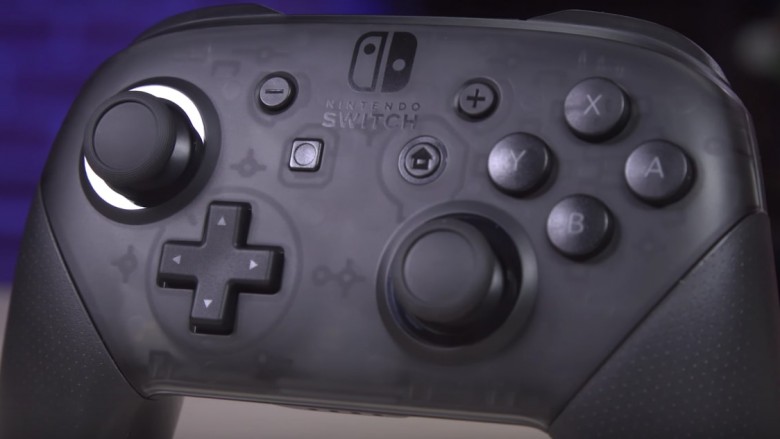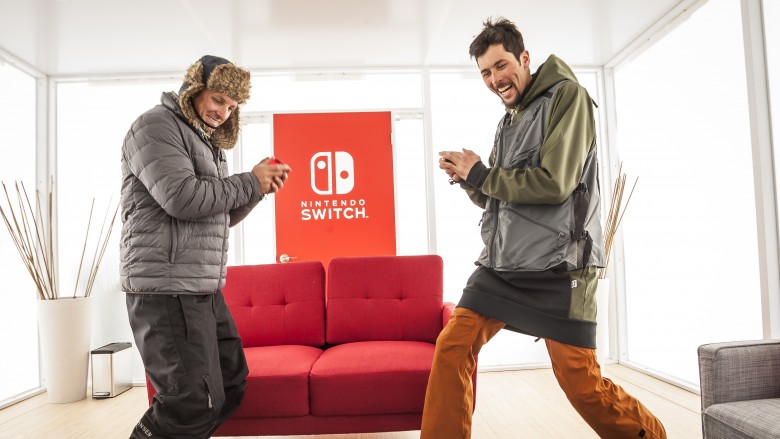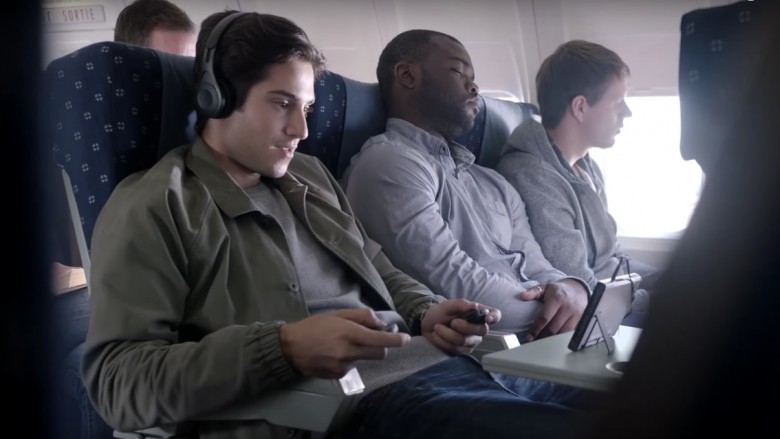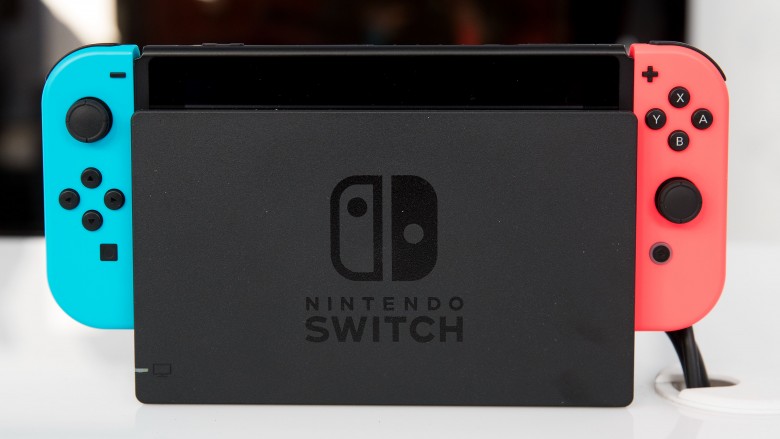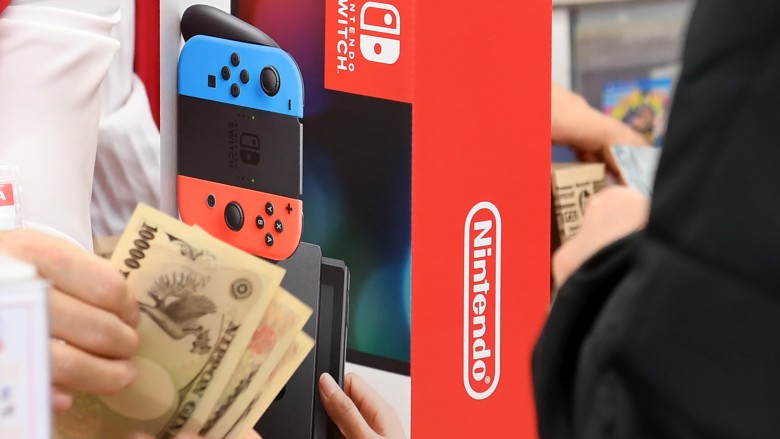The Untold Truth Of The Nintendo Switch
Much has been said about Nintendo's latest, much-anticipated piece of hardware, the Switch. The handheld console hybrid has intrigued and impressed critics and fans alike since its launch on March 3, but behind all the pre-release hype and positive reviews, there's a whole hidden story about the Wii U's successor. Let's take a look at the untold truth behind the Nintendo Switch.
Footage in the reveal video was entirely fake
Remember how sweet that first official "First Look at Nintendo Switch" announcement trailer was—what with all the dog walking, meeting hot chicks at the airport, playing Skyrim on a plane, Mario Karting in the back of a van, shootin' some virtual b-ball with your bros after playing real basketball—as well as, of course, the now-infamous super hip rooftop-party Mario Odyssey play session with Karen? (Who could forget?) We hate to burst your bubble, but guess what? It was all fake.
After some eagle-eyed viewers spotted evidence of post-production paste jobs in the trailer, Nintendo all but confirmed to Eurogamer that none of the gameplay seen in the trailer was real, stating: "You shouldn't assume what you saw on the video represents actual game footage..." Additionally, the trailer did conclude with the following statement: "Game footage not final, graphics and features subject to change." Throw on top of that the fact that one of the actors admitted in a now-private YouTube video to using dummy units during recording, and it becomes rather obvious that all the gameplay shown was added in post-production.
This really shouldn't come as a surprise, as the aim of the trailer was clearly to showcase the hybrid hardware's capabilities, so we won't hold it against Nintendo for throwing us a spitball.
It has a secret web browser
A common complaint surrounding the launch of Nintendo's newest piece of hardware is that the tablet-like device doesn't feature a dedicated web browser, or any way to surf the Word Wild Web's waves. However, some early adopters quickly figured out a workaround.
Though functionality is limited, Switch owners can access Facebook and Twitter, as well as stream videos. According to Polygon, users first need to go into the device's User Settings and navigate to the area in which they're able to link their Facebook accounts. After selecting "Link," users are able to navigate via Facebook links—albeit not without difficulty—and even stream videos posted to the social media service. However, web browsing outside the friendly confines of Facebook and Twitter is currently impossible. Nonetheless, videos on the Switch's 720p touchscreen look downright fantastic, showcasing the device's potential in regards to much-hoped-for YouTube and Netflix support.
Considering the handheld nature of the Switch, future support for web browsing and video streaming is surely in the cards. For now, early adopters will have to make do with this inconvenient workaround.
There's a secret message hidden inside the Pro controller
The Nintendo Switch Pro controller is definitely the premier way to play—at least when lounging on the couch, with the unit docked and connected to your living room's big screen. Not only is the Pro controller well-built and handsome, the partially-translucent pad features a friendly little Easter egg, courtesy of Nintendo.
By pulling the right thumbstick down, craning your head just right and finding the just the right amount of light, owners of Nintendo's premium controller can find a secret message from the hardware's creator: "thnx2 allgamefans!"
Nintendo's attention to detail is already legendary, and this hidden secret serves to illustrate why. And let's be real—nothing makes you feel all warm and justified after spending $69.99 like a secret message just for you. (And everybody else, but mostly for you.)
The cartridges taste awful
We know, we know—our natural instinct is to put video game cartridges in our mouths. It's written somewhere in our genetic code. Most adults, however, have an override switch somewhere deep in our brains, allowing us to resist the urge to taste said cartridges. Those of us who can't resist the urge, however, are in for a rather unpleasant surprise.
As it turns out, Nintendo assumed people would let their curiosity get the best of them, and planned ahead by coating their cartridges with denatonium benzoate. Also known as BITTERANT-b, denatonium benzoate is just that—bitter. Really, really bitter. Like, make you feel gross all over bitter. Like, Nintendo is teaching you a valuable life lesson bitter.
Take it from us, you don't want to try it at home. And you shouldn't anyway. But if you do—don't say we didn't warn you.
You can play Skyrim on an airplane, except when you can't
Think you can just pick up a Switch at your local retailer, hop on a plane and start slaying Skyrim dragons? Well, you can. Think you can do it with your Joy-Cons detached from the Switch's tablet? Well...that's a horse of a different color.
Anyone who's hopped on a commercial flight knows the deal: during takeoff, open your window blinds, make sure your seatbelt is fastened and your seat is in its full upright position, and turn off all electronic devices. (Which nobody ever seems to do.) Once you're cruising, however, most flights let you use your electronic devices in "airplane mode"—and the Switch is certainly not an exception to the rule. How, then, is that dude in the Switch reveal trailer playing Skyrim with his Joy-Cons detached from the main unit—considering the Joy-Cons communicate with the console via bluetooth technology?
Well, in short, it seems to be up to the discretion of the flight attendants. If you put your Nintendo Switch in airplane mode, it automatically disables the Joy-Cons' bluetooth connectivity. However, you can manually turn bluetooth back on with the Joy-Cons attached to the device, allowing you to then re-detatch the controllers. Therefore, the trailer didn't really lie, as some airlines do allow the use of short-range bluetooth devices.
Still, you may want to hide your neon-colored Joy-Cons when the flight attendants come around with snacks, lest they kill your buzz by putting an end to your comfortably-untethered questing.
Vinyl skins will ruin it
Those planning on customizing their new Nintendo Switch with some sweet vinyl skins will want to think twice. According to popular skin manufacturer Dbrand, adhesive-backed skins and wraps do not react well to both the Joy-Cons' and tablet's material. In fact, they'll straight up ruin it, as both the outer coating and logos will peel off—which is a major bummer, as we're pretty sure wrapping that bad boy in any sort of skin would look majorly badass.
At least the Switch looks sexy as is...which is more than can be said about the Wii U.
You can drop it 11 times
Ever wondered how many times you can drop a Nintendo Switch from a height of five feet directly onto concrete? (Who hasn't, really?) Well, we're all in luck! YouTube channel GizmoSlip has done the dirty work, putting Nintendo's newest piece of hardware through a torture test.
The footage is almost too painful to watch, unless you enjoy witnessing expensive gaming hardware be methodically destroyed. (Sicko.) However, thanks to GizmoSlip's durability test, we now know that an extremely clumsy person can drop their Switch onto concrete somewhere in the vicinity of 11 times before the unit becomes totally unplayable.
All things considered, the Switch actually seems pretty durable—but all the components scratch with ease. Looks like you better get yourself a protective case and screen protector if you wish to keep your new device nice, clean and shiny.
It can make secret noises
In classic Nintendo fashion, the company's newest piece of gaming hardware features some nifty little Easter eggs in its user interface.
Reminiscent of the GameCube, Switch users can play with their system's sounds. Upon awakening from sleep mode, the undocked handheld prompts the user to press any button three consecutive times as a means of unlocking it. Press any normal button (we hate to stereotype), and you'll hear a fairly standard clicking sound. Press any special button, though, and you'll hear something else. ZL gives you a slightly less-typical metallic click, whereas ZR gives you a comical bicycle horn. Clicking the left stick results in a Nickelodeon-esque, springy "boing," while clicking the right stick yields a weird, squeaky sound.
We're partial to pressing ZR when we unlock our Switches, as we really like to...clown...around. (Thank you, thank you. We'll be here all week.)
The Switch ad was Nintendo's first Super Bowl commercial
Super Bowl LI viewers undoubtedly noticed the 30-second advertisement for Nintendo's new hardware and major launch exclusive, The Legend of Zelda: Breath of the Wild. What many viewers probably didn't realize, however, is that this was Nintendo's first ever Super Bowl commercial—roughly 32 years after the North American launch of the original Nintendo Entertainment System.
Costing Nintendo upwards of $5 million, the 30-second spot not only showcased the hardware and first must-have piece of software, but also the demographic Nintendo is targeting—namely, millennials with some casual tattoos, retro rotary-dial telephones, and decorative dartboards, who enjoy playing Stratocasters and riding skateboards.
We're pretty sure that owning a Switch does, in fact, make you instantly cooler—regardless of whether or not you're invited to swanky rooftop parties.
Nintendo Switch is one of the cheapest consoles ever released
Those who doubt the Nintendo Switch's $299 asking price at launch as a value can doubt no more. Thanks to a comparison by IGN of every major console's launch price, price-point haters of the new hybrid console are forced reevaluate their worldview: the Nintendo Switch is the fourth-cheapest console, at launch, of all time when adjusted for inflation.
The only significant non-Nintendo console ever to have launched at a cheaper price point than the Switch is the Sega Dreamcast, with Nintendo's GameCube and Wii being the only other cheaper-on-day-one units. With the cost of Nintendo's peripherals considered by many to be too high, and with Nintendo often believed to mildly overprice their products, this comparison seems to actually position Nintendo as a very reasonable hardware developer. None of this, however, changes the fact that we're disappointed about the lack of a bundled-in game.



